Elgato has made a name for themselves by focusing on streamers and content creators with everything from capture cards, lighting, green screens, and their stream deck. The one area that they seemed to avoid for a long time was the one area that other companies had taken notice with at all, microphones. That changed recently with the introduction of their Wave:1 and Wave:3 condenser microphones. Over the years I’ve had the chance to check out a variety of desktop microphone options, so I was excited to see that Elgato was getting into the market. Given Elgato’s history of streamer support, I’m curious to see their take on the desktop mic.
Product Name: Elgato Wave:1
Review Sample Provided by: Elgato/Corsair
Written by: Wes Compton
Amazon Affiliate Link: HERE
|
Specifications |
|
|
Interference |
USB-C |
|
Dimensions |
141 x 66 x 40 mm / 5.6 x 2.6 x 1.6 in |
|
Polar Pattern |
Cardioid |
|
Capsule |
17 mm Electret |
|
Dynamic Range |
95dB (115dB Clipguard engaged) |
|
Max SPL |
120dB (140dB Clipguard engaged) |
|
Sensitivity |
-25dBFS (min gain) | 15dBFS (max gain) |
|
Frequency Response |
70 - 20000 Hz |
|
Sample Rate |
48 kHz |
|
Resolution |
24-bit |
|
Weight |
Mic & U-Mount 245 g / 8.64 oz | Base 310 g / 10.93 oz |
|
Requirements |
Windows 10 64-bit – 4GB and USB 2.0 |
|
What in the box |
Wave:1, USB-C Cable, Desktop Stand, Boom Arm Adapter, Quick Start Guide |
|
Warranty |
2 years |
Photos and Features
For the packaging on the Wave:1, it sticks with the Elgato styling which is a combination of dark and light blue in the background. The front has a picture of the microphone on its stand in the center. Up to they just have the Elgato logo with the Elgato down at the bottom in a small font. The model name is up top in a big easy to read font. Then they explain what the Wave:1 is under the picture, mentioning it is a premium microphone and a digital mixing solution. The side has a few features noted along with a list of everything that comes in the box at the bottom. The other side also has the dimensions and weight as well. On the back they have another picture, this time of the Wave:1 in use including the software in the background and they highlight those features again. This time the features also have descriptions as well.




Inside, there is a second box which again has the light and dark blue colors as well as a large Elgato logo up on top. When you open it up you have a card with setup instructions on it and a tray that sits on top with a box for accessories. Once you lift that, you can find the microphone hidden away wrapped up in plastic with its own pressed cardboard tray formed around it to keep it safe.




Inside the accessory box, you get three things. There is a small booklet with safety instructions, aka fine print. Then you have an adapter for a traditional boom arm that takes the Wave:1 from the camera style mount to a normal microphone mount. Then you have the USB cable. The cable isn’t sleeved or anything out of the ordinary. It does have a thick rubber covering which should hold up well. It has a Type-A connection on one in and Type-C on the other, which I like seeing a lot after having issues with our Yeti X’s cable. It is around 5-6 feet long as well to help if you decide to mount up on an arm away from your PC.



So having just finished our coverage of the Blue Yeti X not long ago and jumping into the Wave:1 the difference between the two is staggering. The Yeti X is very large where the Wave:1 is a lot more compact. The Wave:1 is 141 mm tall or 5.6 inches tall where the Yeti X was around 8 inches tall. That is just for the microphone itself, not counting the stand. I’m surprised that Elgato doesn’t include a measurement with the stand as well. The Wave:1’s stand adds just over 2 inches for a total of 7.6 inches tall where the Yeti X is 11 and a half inches tall. The Wave:1 is more compact for width as well and its more boxy shape is thinner. The base is an inch wider as well. A smaller size isn’t a requirement when it comes to microphones, but if your desk is covered in monitors like mine is it can be the difference between it blocking everything or fitting perfect. Of course, a stand can avoid all of that and I will talk more about that later. The Wave:1 keeps things simple for styling as well with everything being blacked out and no chrome.


Here is a look at the front of the Wave:1, this is one area where it is different from the Wave:3 as well as the Yeti X which both have a volume indicator where this model doesn’t. Things are simpler. The bottom half of the Wave:1 is plastic and has a single knob on it with an LED right around it. This dial controls the volume of the audio output and doesn’t control your microphone gain or volume which is a bummer. That is a Wave:3 feature, however. It is also a push-button and pushing it will mute and unmute the microphone, they let you know the status with the LED ring around the dial which is white when it works and red when muted. This makes it easy to see and the unmuted white color doesn’t give a weird glow towards your face as well which is a small detail but a nice touch. The top half of the microphone has a metal grill with small holes in it and a single Elgato logo up at the top. This along with a foam layer under it helps protect the microphone condenser capsule from light wind and moisture. Another area where this design is different from the Yeti X is that with the Yeti X they included multiple pickup patterns for different types of use, four to be specific. But Elgato has gone with just the one Cardioid pattern which is what most people would want to use for single person use aka streaming. It isn’t going to be ideal in a two-person interview and it doesn’t do stereo. The capsule has a dynamic range of 95dB and a max SPL of 120dB. For sensitivity it starts at -25dBFS but can reach 15dBFS at max gain. The frequency response is 70 - 20000 Hz which is close to the Yeti X only the Yeti X does lower down to 20Hz. As for the DAC inside of the Wave:1 that converts everything to digital for your PC. The Wave:1 runs a 24-bit resolution with a sample rate of 48 kHz which is the same as the Yeti X. Sadly Elgato doesn’t have a signal-to-noise ratio listed, which is something I was curious about as well.


Around on the back is where you will find the two connections. They went with a Type-C connection for the USB on the left and the right is a standard headphone jack. This being on the back cover on the bottom like the Yeti X seems like it may hold up better and not receive stress when moving the microphone around, just as long as you don’t have it back against anything. The Type-C is also a little more durable as well.

The stand for the Wave:1 is really simple in design. It has a thick metal plate for a base that has rubber on the bottom for grip. They even hid all of the certification logos down on the bottom as well. It then has a metal rod with a threaded top up the center which screws into a plastic U-shaped mount at the top. That U shaped mount also has rubber used around the two side mounting screws. Normally I would prefer an all-metal design which is what the Yeti X had, but I like the mix of materials here. You get the durability of the metal as well as the weight to help keep things stable. But switching to plastic with the rubber at the top helps give the microphone some isolation which the Yeti didn’t have. So if you plan on using this on your desk, it should take out at least some of the vibration. They also have an extension pole available to raise the microphone up higher if you prefer.



Accessories
I kind of hinted at it earlier, but Elgato didn’t just drop their two microphones and leave it at that. They have a lot of accessories that you can pair up with either microphone to get your desk setup perfectly. They have an extension for the stock base if you want that to be taller for example, but after having the Yeti X sit in front of my monitor for months that wouldn’t work well with my desk. They also have a pop filter, which I sadly didn’t get in to check out. But they did send over the shock mount which lets you use the Wave microphones with an arm and to isolate it from vibration. Then they have their multi-mounts which aren’t Wave specific, in fact, they have had them for a while now for mounting their key lighting and for cameras. They sent over a multi-mount stand and flex arm kits as well as the shock mount. So before diving into testing I wanted to touch on each of them a little to show what they do.

So the shock mounts box has that same light and dark blue background and they did a great job of showing the mount while also showing a line drawing of the microphone inside of it as well as an arm to show what it does. There is also a picture on the back that shows that as well. Then on the side, they list what is inside. You get the mount which comes wrapped in plastic, a quick start guide, and adapters for different mounting thread sizes.





If you haven’t seen one before, basically the mount has two main components that are completely independent of each other. The main ring on the outside ties back into the arm mount. Then on the inside, there is a second smaller ring which is what the microphone mounts to. It uses the same two thumbscrews on the side of the microphone as the stock mount along with rubber grommets on those holes for some isolation. Then they use an elastic string looped between the two halves to hold the microphone inside of the main mount. This isolates the microphone from outside bumps and vibration which is a big issue with desktop microphones. The arm mounting end comes with the smaller adapter preinstalled and this is what the Multi-Mount and the stock mount use so this makes installation that much easier. It also has a pivot built-in with a locking screw depending on if you are mounting to the stock stand or an arm that is coming from the back.








Next up I had the Multi Mount itself which doesn’t get the same blue box treatment as the microphones and shock mount. This is just a brown box with the Elgato logo and the name on the top of the box. Inside formed cardboard holds the stand as well as a folded up instruction paper to get you setup and that’s about it.



So they have an add on to make this a free standing stand, but it comes default with a cable clamp. The clamp has the only Elgato branding on it which is nice and it is a little nicer than you would find on a cheap stand off Amazon. For one both the inside and outside of the clamp have foam to try to help you protect your table when you tighten it down. Also, the crank itself surprised me. They could have gone with a simple T handle and be done with it. But they used this larger arm. But to avoid an issue with the longer arm if you are tightening this down up against a wall you can pull on the arm and it will move its position. So say you are against a wall you can tighten until you hit the wall, pull and spin it back around. The other benefit of that is when you get it tight you can pull and move the arm as far out of the way as possible. This arm does extend as well and they have two sizes. This is the L model which is 22 inches long at its shortest and 49 inches at full length. The short version is 17 at short and 29 at full length which honestly is the better option when using this for a microphone arm. The extensions have rounded locks with grips to lock the mount at any specific hight and from playing around I can say they do a surprisingly good job of locking in place. At the end of the mount, there is a ball pivot mount that comes with a camera style ¼ inch screw and a rubber grip. There is also a wingnut that lets you loosen and tighten the ball up.








Before getting into the last box I did hook the shock mount up just to see how it would work. This alone could work with a lot of desks, especially if you mount it to the side of your desk. But for mine, I have a 3+1 monitor stand that I need to get up over top of while also coming forward enough so it's not hidden back behind the monitors.

So for bridging that distance you will need a Flex Arm kit which again comes in a small and large size. This is the large kit and it comes with four poles. One is 9.45 inches long, one is 6.7 inches long, then you get two short poles that at 3.15 inches long. They are all steel and come with a ball on one end and the same pivot mount that the main pole comes with on the other. You loosen the wingnut up until you can fit the ball in and add them together to get the job done. The small flex arm kit gets you just the 6.7-inch pole and one 3.15 inch pole. Which again, for a microphone arm or even if you were using this to mount a key light or camera at your desk would most likely work.





Before moving to my desk for testing, I did play around with the arm using ALL of the flex arms and I was really surprised at how well things could hold. I didn’t have to crank things down at all for them to grip and not move. This is because each of the pivot balls have a stair-step effect machined into them to help lock them in place. Even still I expected with multiple arms pulling at least one would move. This isn’t like a traditional microphone arm though that is spring loaded and you can move around freely. These lock in place and don’t move. Elgato also has a few other arm accessories like a solid arm that you can attach anywhere to add a second or third device. You could get wild and have your camera attached as well as a key light or even your phone using their phone mount.


Performance
For performance testing, there were three areas that I wanted to test out. Software to check out how you control the Wave:1, especially with Elgato specifically calling this a mixer and a microphone. Then we have normal microphone performance. Then lastly, all of the other aspects like how the included stand works, the controls, etc.
So I thought that maybe with this being a new launch that it might be integrated with Corsair’s iCue software. But like with the Stream Deck the Wave:1 has its own software. That worked well for the Stream Deck which iCue could learn a LOT from, so I can’t fault them too much for sticking with the solo software. It is called Wave Link and once installed you just have this one page which keeps things extremely simple. It has a list of different inputs at the top and down at the bottom options for your outputs. Hey, they weren’t kidding when they said this was also a mixer!

So in the outputs section down at the bottom, you have two outputs at all times. One is called the monitor mix and this is what you hear. Then Wave Link created virtual outputs to let you have a second mix that is completely different which they call the stream mix. This is a huge feature, they are integrating Virtual Audio Cable which I have used in the past to be able to tie things in together like this. Down at the bottom you can pick which device you want to monitor things on and there is a meter next to that mix along with volume control for it. Then you have a stream mix and clicking the drop-down here just opens up a box explaining that for your streaming software you need to select the Wave Link Stream source that they have created and this will then let you control what your viewers hear apart from your own audio.


Then for inputs, each input can be selected up at the top. You can rename them and control different things. For the Wave input, this is from the microphone. So you can adjust the gain, the overall output volume, and the microphone/PC mix. Selecting any of the other options has a different set of options that let you pick an input. Then once setup you can see meters to show the audio level, even if you have things muted. Then each has volume control for both your monitor mix and stream mix. You can also click on the icon at the bottom for a full mute. Here you can make music quite or muted for your stream (DMCA) but still listen to music. I’ve done this in the past by outputting my music to my speakers but then using my headphones for voice chat. You can do the same for your browser, letting you double check to make sure something doesn’t have anything inappropriate in the audio before showing it on stream.
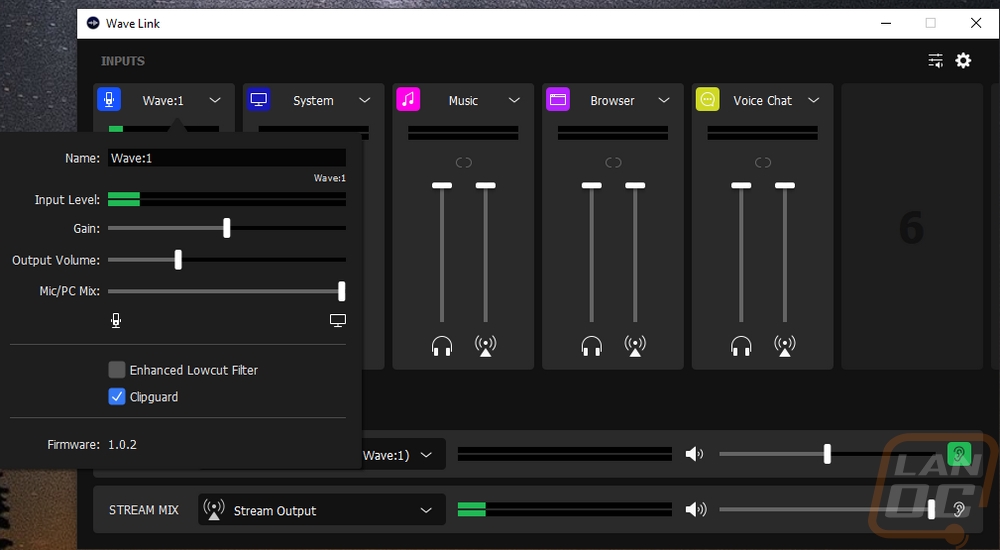
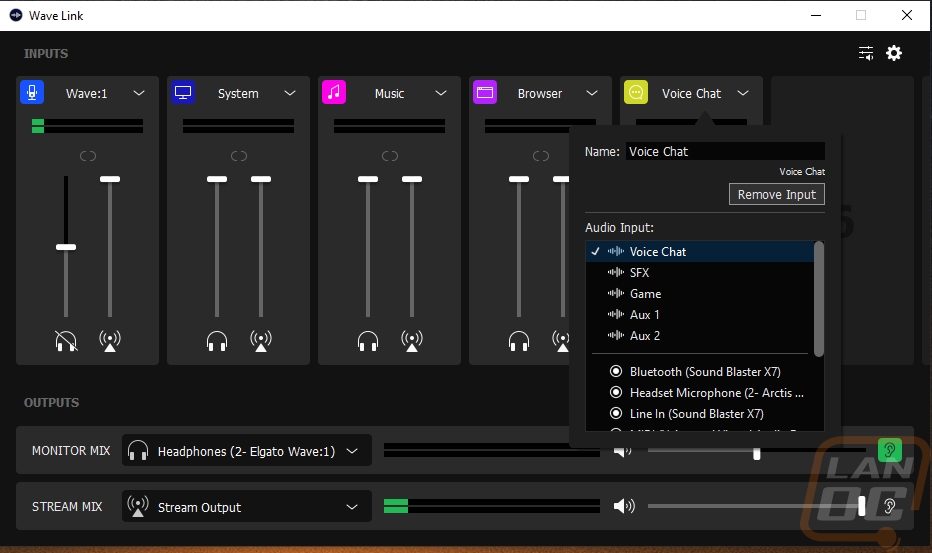
The only other option in the software is the gear for settings. This gets you the check for updates button and the software version. You can also set if the software turns on when you boot up or not.
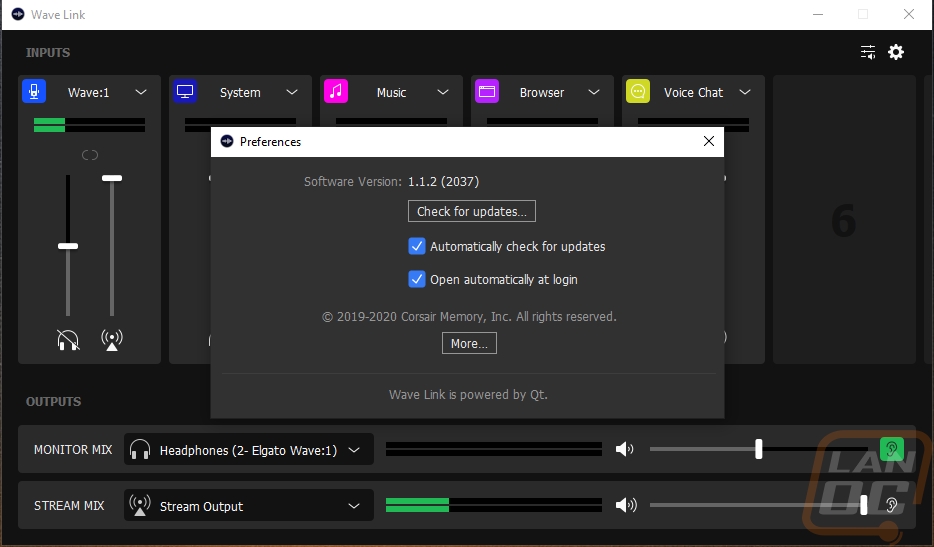
So the other half of this equation is using the Windows 10 app volume and device preferences page and they do make it easy to get to with it sitting next to the gear with the slider button. Here you can set different outputs and inputs for different programs. Which if you are like me and have multiple headphones, speakers, and each monitor has audio you can use this alone to do some crazy stuff. Seriously, you can set up a kid to watch something and lock it to a specific pair of headphones. Or if you are fancy you could output audio from a specific app to say your whole house speaker system while playing DIFFERENT audio somewhere else. The way Wave Link works though is each of those inputs in the software (which you can create as many as you want) also creates a virtual audio device for windows. On this page, you set the corresponding program to output to it. So say you have Spotify installed, you would want to set that to output to Wave Link – Music. That way the wave link software picks it up and you can control how much your stream hears and how much it doesn’t. The only downside is that your web browser can only be set to one, so you couldn’t set that page by page.
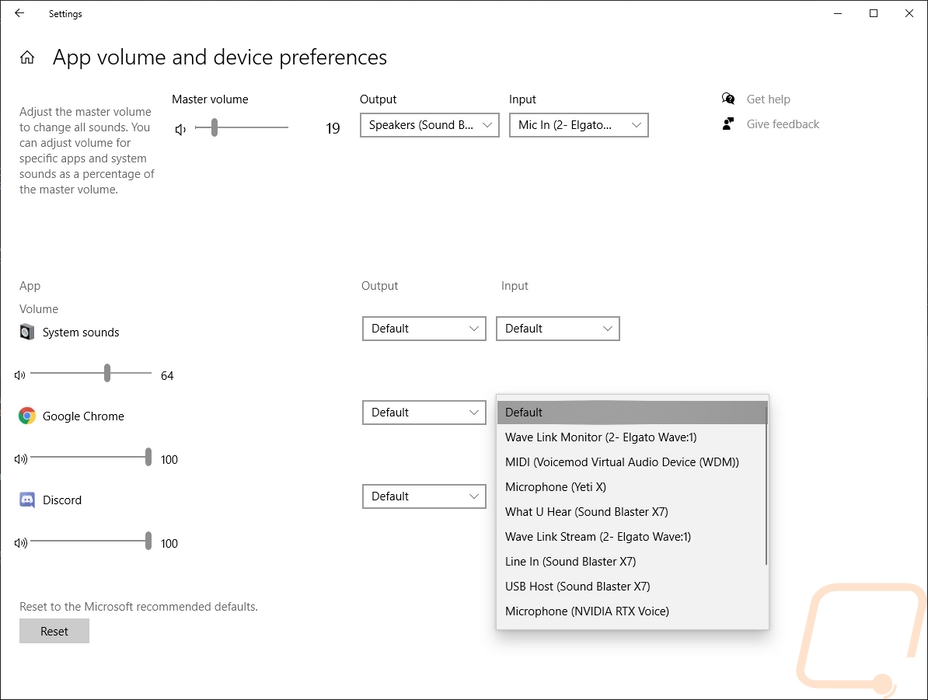
For comparison testing, I put together a video comparing the Wave:1 against a variety of products. This includes the Yeti X that I just recently reviewed as well as an older Razer Siren for desktop microphones, a whole variety of wired and wireless headsets, a few Mod-Mics, and even a webcam microphone for comparison as well. I’ve left the video below to let you decide on how each of them sounds. Being a desktop microphone, the Wave:1 does pick up exterior sounds like your keyboard and mouse. The Wave:1 was shockingly sensitive when I turned the volume all the way up. When listening to myself talk at that level, not only did it pick up every PC sound in the house but it was picking up the sound from the headphones I was wearing and echoing. I’ve never had that happen before. My testing was done closer to 75% of volume level but I would most likely run a touch lower in voice chat to help cut out more sounds like breathing. The difference between the Wave:1 and the Yeti X set to cardioid only came down to the difference between being mounted to an arm and sitting on the desktop. Both picked me up perfectly and they also stand out and show why a desktop microphone is the way to go when you compare against all of the headset microphones as well except for the Mod-Mics.
As far as the other aspects of the Wave:1. For starters, I love the integration with the shock mount and Elgato’s Multi Mount setup. But even the stock stand was surprisingly good with the heavy base combined with the plastic mount up top to help cut out at least some vibration. My only other usage issues came from moving from the Yeti X which has a built-in volume meter to let you quickly see how loud you are and to go with that the volume knob controlling the microphone volume which the Wave:1 doesn’t have but are both features on the Wave:3. I don’t mind the single pattern design that they have gone with, at least for at your PC use. I would most likely look at a different microphone for doing a podcast unless I wanted to use more than one microphone. I also think the more compact size helped a lot, when I used the Wave:1 with the original stand it didn’t block my monitor like the Yeti X did, and even on the arm, it is less in your face, even with it being right up in my face.
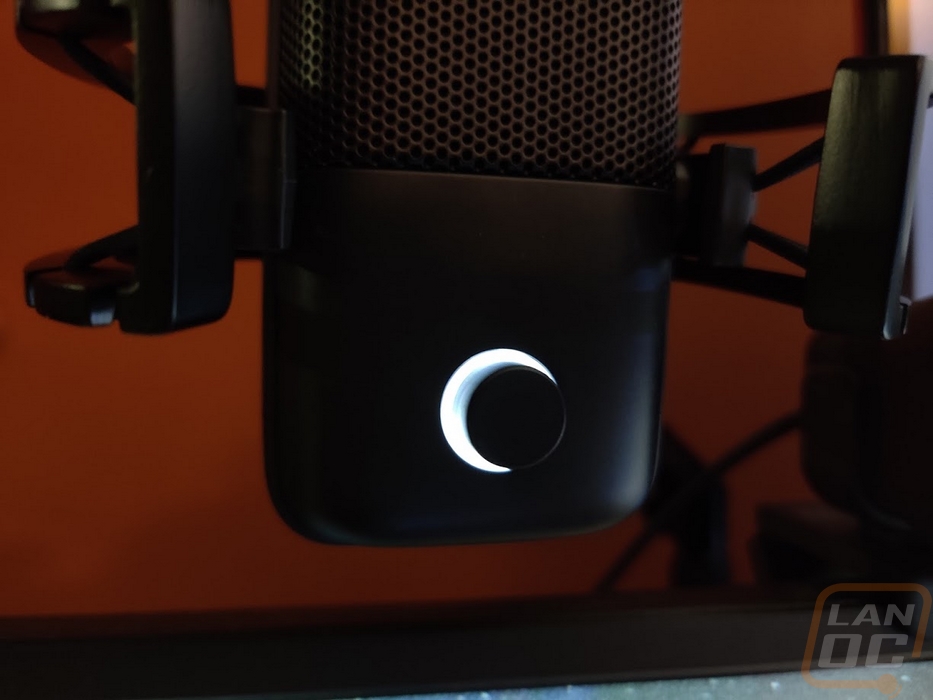
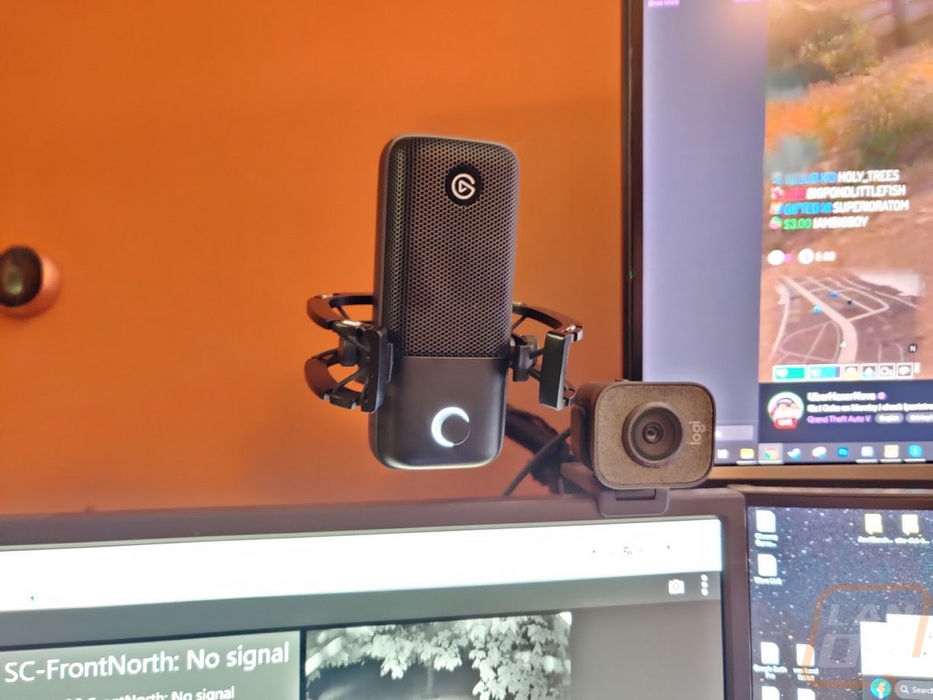
Overall and Final Verdict
Coming in to my testing with the Wave:1, I was excited to see what Elgato would do differently than everyone else. They have shown themselves to be great at looking at the streamer market and being able to spot openings where companies aren’t making anything at all like with their Stream Deck and green screen. Or at least not making anything focused specifically at streamers when it comes to products like their key lights and capture cards. But when it comes to microphones, multiple companies have been making them for a while now. Blue Microphones is well known because of their Snowball and later Yeti microphones. Well, the big thing that they did was actually on the software side where they have included a full and proper mixer to let you control multiple sources audio output to both your stream mix and your monitoring mix. Something that a lot of people have been using more traditional mixers for.
Beyond that, though I like the singular focused design that doesn’t worry about having multiple pattern types which means one less button or option for people who don’t know anything about audio to worry about. Small details like the USB connection being at the back and it being Type-C which is a little stronger is nice, especially after having problems with our Yeti cord. But it is the accessories that you can go within the “Elgato Ecosystem” that impressed me. The Wave microphones have a few exclusive accessories like a shock mount and a pop filter which at least for the mount most good microphones have as an option. But even the extension pole for the base is a nice way to let people set the Wave:1 up to the height you need. BUT if you go with the shock mount you can drop the original stand altogether and use their Multi Mount to mount it up over your monitor and potentially even integrate a key light and or camera mount as well. Diving into that end of things can get expensive compared to other options on the market. But Elgato at this point is kind of curating things to make it easy for a streamer to throw down and upgrade their setup all at once without having to spend time shopping for each component.
Now the Wave:1 wasn’t perfect. I missed not having control of the microphone volume with the built-in dial like I had with the Yeti X. I also missed not having an on microphone volume meter. Both of those are Wave:3 features however so really that would be a better option for what I am looking for. I have the software not integrating with iCue or past Elgato products listed here as well. It’s a great program, but I also like not having to run multiple programs when possible.
As for pricing, the Wave:1 has an MSRP of $129.99. This comes in right in line with the traditional Blue Yeti and from Razer, the Seirēn X has an MSRP of $99.99. If you are only talking about the microphone, the Seirēn X feature-wise is closest to the Wave:1. The Yeti does get you the tri array microphone for different patterns, not that I think that is a feature a streamer would need. But the Wave:1’s real variable is in the software where no one else is offering anything like it. I wouldn’t mind seeing the price come down a hair to be a little closer to the Seirēn X once microphone availability from COVID calms down. But overall I think Elgato has a good product here, especially for streamers with their mixer software.


Live Pricing: HERE




